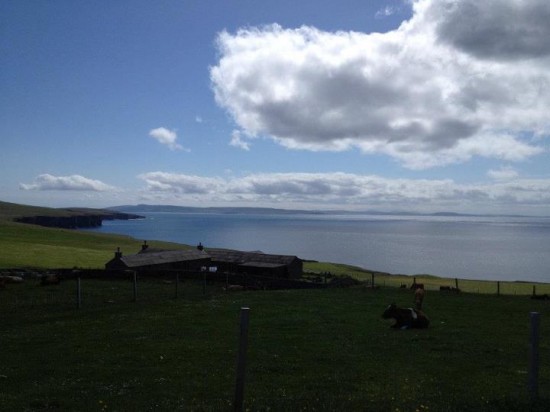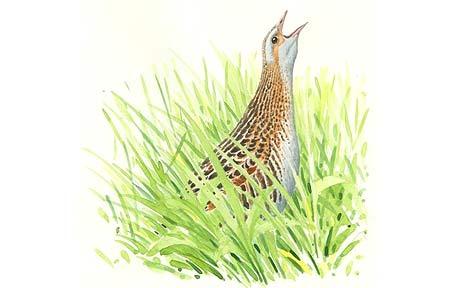
by Amy Liptrot
Older Orcadians tend to refer to women, regardless of marital status, as ‘wives’ so, arriving at a farms to speak to farmers about the endangered birds on their land, I am announced with “the corncrake wife is here”.
In my capacity as the Corncrake Wife, I have had to visit some of the smaller Orkney islands. There are 20 inhabited islands, with populations ranging from two to hundreds, and I have now been to all but three (archaeology-heavy Wyre; Auskerry, home to just one family who changed their surname to Auskerry; and Papa Stronsay, where the only inhabitants are a sect of Transalpine Redemptorists monks).
I travel to the islands on the ro-ro ferries that run on bacon butties and in nearly all weathers. I see a couple walking their ferrets off the ferry. These islands are home to a peculiar mix of the type of eccentric, adventurous ‘south folk’ who would choose to move up from say Reading to Stronsay, and the more conservative Orcadians who can trace their family on the island back generations and have watched members move away, as well as incomers come and go. People think that by moving to these small islands they can ‘get away from it all’ when in fact they are required to have more interaction with neighbours in a such a small place. For the most part they get along ok.
On Sanday, I located three corncrakes and heard a story about a cow that swam a mile. I was told on Stronsay about a corncrake that got caught in a lobster creel. On Eday, where there were no corncrakes, I heard about how fishermen on the isles didn’t want to learn how to swim so that if the boat went down they would drown more quickly.
The main reason for the decline in numbers of corncrakes over the 20th century is increasingly mechanised farming methods, in particular larger and more efficient grass mowers. Most corncrakes live in fields intended for hay or silage and when the mowers come to cut the grass, the birds – particularly the chicks – are usually killed. Corncrakes move away from the mower into the ever decreasing area of uncut grass, and are eventually caught in the middle of the field and mown to death on the final swathe.
Once I’ve located the corncrakes – through reports from the public and my night time surveys – I go and visit the landowners. I come to agreements with the farmers, offering them money to delay cutting or grazing the grass, or to mow in a ‘corncrake-friendly’ pattern: from the inside of the fields outwards, giving the birds more of chance to escape. At a farm on Westray – corncrake capital of Orkney with more than 10 – I sit on a dyke and watch the tractors, hoping to see a corncrake moving away, smelling the fresh cut grass, looking out across the sea to lonely Papay, feeling a long way from Hackney.
Visiting the farms has allowed me to get to know the islands: their open landscapes where you can see the sea from everywhere, often in more than one direction. On these islands there are more houses than people now, low ‘butt and ben’ crofts – some derelict some carefully restored and updated – farms from small and old fashioned to modern and slick, rusting vehicles and abandoned baths by the side of the road, caravans held down by ropes and breeze blocks against the Orkney winds. Studying maps and driving the roads I notice farm names: Grind, Woo, Queer, Balaclava, Windywalls, Patience, Flaws, Crook, Stews, Gimps and Gary.

It is incredible that corncrakes migrate all the way from central Africa because when they are here they barely like to fly at all, hiding low in the grass. We only know where they are from the distinctive call that used to be common over the whole UK and has been described as sounding like frogs or crickets, or like dragging a credit card down a comb.sounding like frogs or crickets, or like dragging a credit card down a comb. Males call for 3-4 hours per night solidly, singing for a mate. When you look at it this way, it becomes less an annoyance, more a desperate romantic plea. Where are you?
I’ve learned as much as I can about this one species, reading scientific papers, setting a ‘corncrake’ google alert, seeing the migratory cycle and the conservation industry through the prism of one species. I’m fixated: I set its call as my ringtone and have a folder of favourite corncrakes photos which I post on facebook. I am hallucinating a corncrake call in the background of music on the radio and at night I dream of corncrakes. One night, I got so close to a calling male (although I couldn’t see it) that I felt like I could touch it and my heart was beating like crazy, like a fan meeting a pop star.
Since before I started this job, I’ve been reading Moby Dick. I’ve been reading it for so long it feels like I’ve been on a three-year round-the-world whaling trip, carrying it back and forth every day hefty in my shoulder bag like a harpoon. I’m motherfucking Captain Ahab but instead of a whale I’m chasing an elusive bird. For, although I’ve heard quite a lot now, I still haven’t seen one. Over the winter I was worried about never getting back into the working world, now my confidence is returning: I’m using this time back home to build something up, something strong. So this is what it feels like to have been sober for 17 months, one week and three days.
I reach a total of 32 calling male corncrakes heard in Orkney during the season, just one more than last year. Although numbers still remain low, since the RSPB’s Corncrake Initiative has been running, there has been a slight upward trend in Orkney. Unlike the fabled drowning sailors, the corncrakes are struggling against their demise.
Click here to read Amy’s previous posts for Caught by the River.